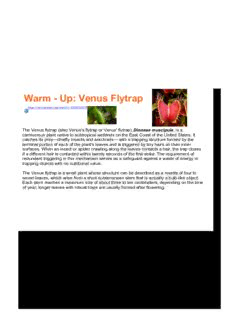
WarmанаUp: Venus Flytrap PDF
Preview WarmанаUp: Venus Flytrap
Warm Up: Venus Flytrap https://www.youtube.com/watch?v=tUDiDAbY3F8 The Venus flytrap (also Venus's flytrap or Venus' flytrap), Dionaea muscipula, is a carnivorous plant native to subtropical wetlands on the East Coast of the United States. It catches its prey—chiefly insects and arachnids— with a trapping structure formed by the terminal portion of each of the plant's leaves and is triggered by tiny hairs on their inner surfaces. When an insect or spider crawling along the leaves contacts a hair, the trap closes if a different hair is contacted within twenty seconds of the first strike. The requirement of redundant triggering in this mechanism serves as a safeguard against a waste of energy in trapping objects with no nutritional value. The Venus flytrap is a small plant whose structure can be described as a rosette of four to seven leaves, which arise from a short subterranean stem that is actually a bulblike object. Each stem reaches a maximum size of about three to ten centimeters, depending on the time of year; longer leaves with robust traps are usually formed after flowering. 1 AP Biology Agenda 1. WarmUp 5 2. Turn in Week Assignments 5 3. Chapter 39 Notes 40 4. Transpiration Lab/Flower Lab 50 5. Start Week Assignments 10 Announcements Due Today: Week 9 Spring Assignments and complete "Getting Started" of Transpiration Lab. Due April 18: Week 10 Spring Assignments Unit 5 Test out of 68 instead of 70 points Quiz Monday! Questions will be from end of chapters 35, 36, and 39. 2 Chapter 39 Notes 3 4 5 I. Signal Transducon and Plant Responses a. A signal transducon pathway couples _________________ of a smulus with ________________ of the organism to the smulus b. 3 stages of cell‐signaling process (Figure 39.2) i. ______________ ‐ target cells have receptors that are proteins that undergo changes in shape in response to a specific smulus ii. _______________ ‐ small internally produced chemicals (second messengers) transfer and amplify the signal from the receptor to proteins that cause the specific response iii. ________________ ‐ usually involves the increased acvity of certain enzymes 6 7 8 II. Plant Responses to Hormones a. General Informaon i. Hormones are relavely _________ molecules ii. They are produced by one part of the organism and translocated to _________ parts (trigger responses in target cells and ssues) iii. __________ quanes are required to induce big changes iv. A reacon depends on the ____________ concentraons of the hormone(s) b. The Discovery of a Plant Hormone…Auxin i. Darwin and Darwin (Figure 39.4) ii. Boysen‐Jensen (Figure 39.4) iii. ____________ (Figure 39.5) 9 10
Description: